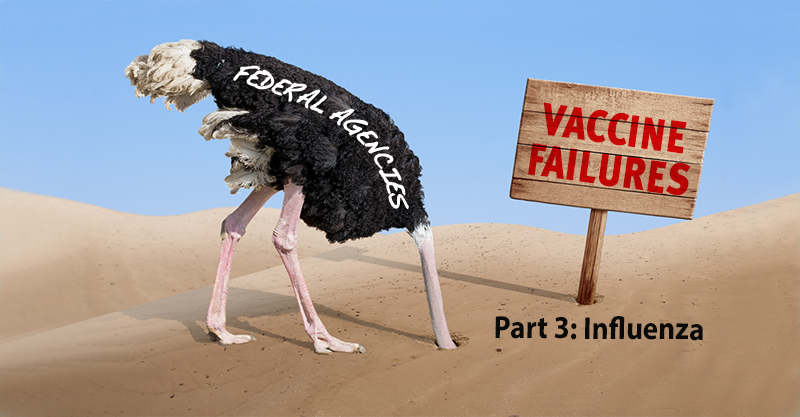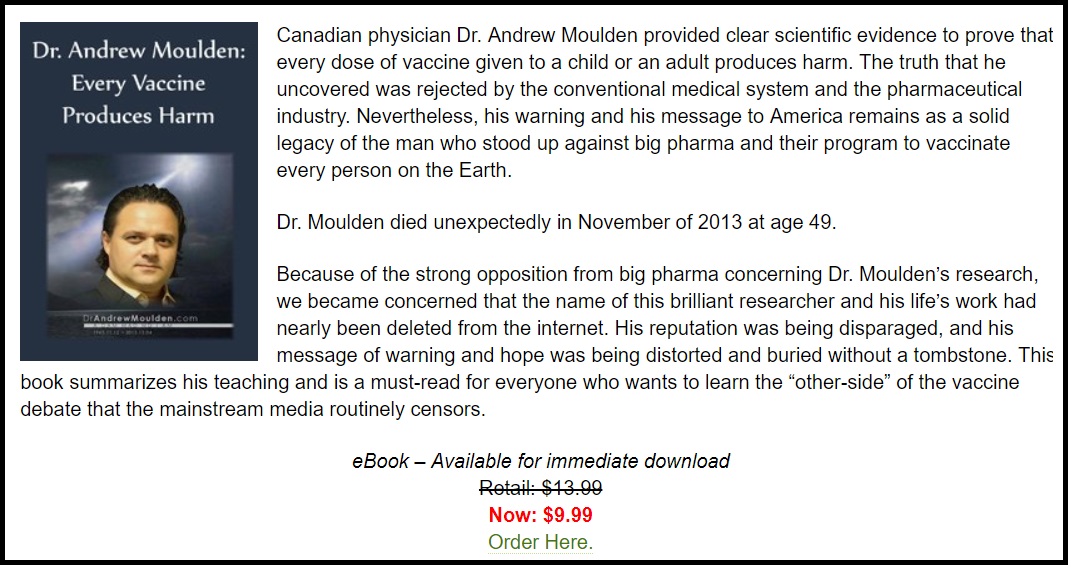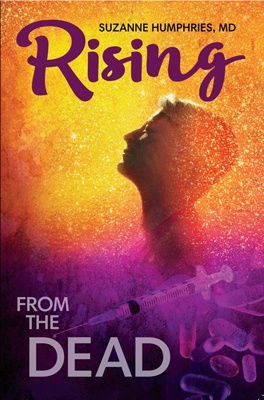Vaccine Failures, Part 3: Influenza Vaccination
by The Children’s Health Defense Team
[Note: This is the third in a series of articles examining the serious problem of vaccine failure—a problem that, scandalously, remains unacknowledged by the public health officials and politicians promoting draconian vaccine mandates. Previous articles examined measles and pertussis vaccination.]
Each year, U.S. public health officials and their media partners renew the campaign to sell the entire country (including pregnant women, six-month-olds and fragile senior citizens) on the need for and benefits of flu vaccines.
Ordinarily, to persuade the public that a given vaccine is beneficial, officials must show that it is effective—in other words, that it is able to “prevent outcomes of interest in the ‘real world.’”
However, influenza vaccination’s infamous ineffectiveness makes this talking point a bit tricky. And when vaccination does not “significantly reduce medically attended influenza illness,” it is hard to avoid the conclusion that the vaccine has bombed.
As public health experts are well aware, many factors can lessen influenza vaccine effectiveness (VE), including particular characteristics of vaccine recipients and the vaccines themselves.
The scientific literature also points to serious wrinkles that underscore influenza vaccination’s inability to deliver meaningful benefits and its propensity to create new problems. For example, studies show that getting flu vaccines year after year reduces the level of vaccine protection available; flu-vaccinated individuals are also more susceptible to other strains of influenza and severe respiratory infections.
Recent studies even suggest that childhood influenza vaccination can lead to larger epidemics and “an overall health loss.” A vaccine expert who recently admitted to knowing less about influenza today than a decade ago lamented,
“It’s much more complicated than we thought.”
Failure #1: Influenza vaccination has been 40%-90% ineffective over the past 15 years.
Thus far for 2019-2020, the CDC says that it can only speculate about how well the season’s influenza vaccines “might work” [emphasis added]. To compensate for this vagueness, the agency touts VE in past seasons as being “in the range of 40% to 60%” (a range that vaccinologists would consider abysmal for any other vaccine). What the CDC does not mention is that last year (2018-19), overall VE (across all age groups and influenza viruses) was a mere 29%, and for the pesky influenza A(H3N2) viruses that predominated after
February 2019, flu vaccines were ineffective 91% of the time. Moreover, VE has attained the CDC’s vaunted upper limit of 60% only once in the past fifteen years; in over half (8/15) of the years since 2004, influenza vaccines have failed 60% or more of the time—including 90%, 79%, 81% and 71% in 2004-05, 2005-06, 2014-15 and 2018-19, respectively.
Failure #2: Influenza vaccine effectiveness is highly inconsistent and ignores immune system complexities.
More so than with other vaccines, researchers view influenza viruses as “dynamic” and influenza VE as a “moving target.” These characteristics have thwarted efforts to develop effective vaccines, with dramatic seasonal fluctuations in VE being the inevitable result.
Under such circumstances, influenza vaccines theoretically will be most effective when manufacturers correctly guess which strains of virus to include in a given year’s vaccines. In practice, however, influenza vaccines also “stand out for their variable effectiveness by age group . . . and by recent vaccination status,” suggesting an important role for immune history as well.
Illustrating the “complex host-virus interactions that affect vaccine protection,” some researchers hypothesize that imprinting—how a person’s first influenza infection “shap[es] immune memory . . . over the individual’s lifetime”—may play a key role in subsequent infection risks.
Proponents of this hypothesis point to a study showing that vaccination tampered with protective childhood imprinting in a cohort of 35–54-year-olds; vaccinated individuals in that age group had a more than four-fold increased risk of illness from certain circulating influenza viruses compared with same-age unvaccinated individuals.
In another example of how immune factors influence VE, studies show that obese individuals have a decreased response to seasonal flu vaccines compared with non-obese individuals.
Researchers explain this by noting that overweight introduces changes in metabolism that alter and age immune system cells; one researcher says that a 30-year-old obese person’s immune cells look “a lot like what you might expect in an 80-year-old individual.”
Failure #3: Influenza vaccine effectiveness dwindles with repeated vaccination.
A 2020 study published by Canadian researchers assesses the impact of repeated influenza vaccination on “current season” VE, furnishing results that will hardly be good news for proponents of annual vaccination.
The study included senior citizens with laboratory-confirmed influenza who were at least 65 years old at the time of vaccination, examining the impact of prior vaccination for up to 10 previous flu seasons—the first study to review such a long time period. In seniors who received a vaccine in 2015-16 but none in the preceding decade, VE was an unimpressive 34%, but it was significantly worse when accounting for 10-year vaccination history—26%, 24%, 13% and 7% in those who received 1-3, 4-6, 7-8 or 9-10 vaccines in the prior decade, respectively.
A Spanish study of older (> 60 years) influenza patients documented low VE (20% or lower) with just one prior vaccination.
What about at the younger end of the age continuum?
The authors of a 2017 meta-analysis point out that, based on average life expectancy and current vaccine recommendations, a child born in 2017 can “expect to receive 70-80 annual influenza vaccinations” over the course of his or her lifetime—but the effects of so many annual vaccines “on individual long-term protection, population immunity, and virus evolution remain largely unknown.” Another researcher—commenting on why influenza vaccines so often fail—remarks that flu vaccination programs are “predicated on assumptions on top of assumptions.”
The authors of the 2017 meta-analysis note that “signals of concern regarding potential negative effects of repeated vaccination” are nothing new, having first been observed in the 1970s and 1980s.
In their conclusions, not only do these authors argue that repeated vaccination “blunts” the antibody response—particularly for the H3N2 influenza viruses that caused U.S. vaccine effectiveness to plummet in 2019—but that the long-term immune effects of “blocking natural infection in healthy individuals with a low risk of influenza complications are unknown.” Their take-home message, again, is hardly reassuring:
Our current understanding of repeated vaccination effects is inadequate to inform vaccine policy recommendations.
Failure #4: Influenza vaccines can increase recipients’ susceptibility to non-vaccine influenza viruses and other acute infections.
In the aftermath of the 2009 influenza A (H1N1) pandemic, two Canadian researchers reported a more than two-fold increased risk of H1N1 illness in individuals less than 50 years who had received a 2008 seasonal flu vaccine.
To explain this finding, one of the investigators theorized that the seasonal vaccine “protected against an H1N1 virus that was related to—but not similar enough to—the pandemic virus,” which “might actually have facilitated infection with the pandemic virus.”
Although the Canadians characterized the 2009 pandemic as relatively mild, they observed that “a potential doubling of pandemic infection risk among prior seasonal vaccine recipients could be disastrous in the event of a more severe pandemic involving a higher per-case fatality risk.”
Not long after the 2009 H1N1 pandemic, other investigators reported on the potential for vaccination programs to shift influenza infections in such a way as to produce less favorable outcomes—a scenario rarely considered during pandemic planning. They hypothesized
“that vaccinating to prevent a fall pandemic wave might delay it long enough to inadvertently increase influenza infections in winter, when primary influenza infection is more likely to cause severe outcomes [and] potentially cause a net increase in severe outcomes.”
A 2012 study of 6–15-year-olds found that children who received a seasonal influenza vaccine (versus placebo) were more susceptible to acute noninfluenza respiratory viruses in the nine months following vaccination, whether during winter or summer.
In an effort to explain this unexpected result, the investigators discussed the phenomenon known as “virus interference” and speculated that vaccination “could increase influenza immunity at the expense of reduced immunity to noninfluenza respiratory viruses, by some unknown biological mechanism.”
Interestingly, a 2020 study of virus interference in highly vaccinated U.S. military personnel reported an increased odds of coronavirus and human metapneumovirus (a virus that causes respiratory infections) in personnel who received influenza vaccines, although the findings pointed in the opposite direction for the other noninfluenza viruses examined.
Failure #5: Many influenza vaccine researchers are disingenuous or worse when they report on vaccine effectiveness.
As Children’s Health Defense has enumerated elsewhere, the proponents of flu vaccines—whether public health officials, the media or researchers—are only too willing to provide misleading information. A multicountry study funded by GlaxoSmithKline (GSK) and authored by GSK employees and shareholders—published in The Pediatric Infectious Disease Journal in 2019—furnishes an illustrative example:
- The GSK authors report that they evaluated a “total vaccinated cohort” of 12,018 children; however, a companion publication clarifies that only 6,006 actually received the GSK-manufactured influenza vaccine.
- The remaining 6,012 children comprised a control group, a group the researchers describe as “unvaccinated”; in fact, these children received one of three “non-influenza control vaccines” (hepatitis A, varicella or pneumococcal conjugate vaccine)—presumably also GSK brands.
- The researchers did not start collecting illness information until 14 days after vaccination, precluding any consideration of short-term post-vaccination adverse events. Without information about adverse events in influenza-vaccinated children, it is impossible to assess the risk-benefit context of the authors’ conclusion that 19 children would need to receive the vaccine to prevent one case of influenza or that 6,024 children must get a vaccine to prevent one case of severe influenza.
- The researchers admit that they focused exclusively on “pre-specified symptoms,” limiting their ability to capture the “whole clinical picture.”
- They report “little difference” in severity scores for influenza-like illness and lower respiratory illness between the two groups but describe a lower rate of fever in the influenza-vaccinated group. However, they make no mention of clinical trial data showing that fever is a “very common” reaction to GSK’s hepatitis A, chickenpox and pneumococcalvaccines.
A Dutch study recently reported that childhood influenza vaccination “is not cost-effectivewhen only outcomes for the children themselves are considered.”
Analyzing the risk of undesirable outcomes—such as “a decrease of health or an increase in the number of severe influenza seasons after introduction of the influenza vaccination program for children”—the Dutch researchers produced worrisome models showing that “serious strain on the health care system” or “a net health loss” could result from childhood influenza vaccination.
Given the many ambiguities present in the GSK study, one wonders whether it could be masking similarly discouraging findings.
Failure #6: Flu vaccine hype is just that—hype.
Is the annual flu vaccine sales pitch (evident not just in the U.S. but around the world) working? Given predictions of a 50% increase in the global influenza vaccine market by 2023 (from $5 billion to $7.5 billion), it would seem so.
On the other hand, recent estimates of influenza vaccine coverage in U.S. adults show that Americans are growing more, rather than less, skeptical.
In 2017-2018, influenza vaccine coverage fell for every adult age group (and all but one racial/ethnic group), reaching the lowest level in eight flu seasons. While influenza researchers may be “hesitant to discuss problems with the vaccine ‘because they’re afraid of being tainted with the antivaccine brush,’” we must hope that members of the public will recognize the importance of reviewing flu vaccine facts very carefully.
Read the full article at ChildrensHealthDefense.org
© 2020 Children’s Health Defense, Inc.
This work is reproduced and distributed with the permission of Children’s Health Defense, Inc.
Want to learn more from Children’s Health Defense? Sign up for free news and updates from Robert F. Kennedy, Jr. and the Children’s Health Defense. Your donation will help to support them in their efforts.
Leaving a lucrative career as a nephrologist (kidney doctor), Dr. Suzanne Humphries is now free to actually help cure people.
In this autobiography she explains why good doctors are constrained within the current corrupt medical system from practicing real, ethical medicine.
One of the sane voices when it comes to examining the science behind modern-day vaccines, no pro-vaccine extremist doctors have ever dared to debate her in public.
-
Book – The Vaccine Court, by Wayne Rohde – 240 pages
“The Dark Truth of America’s Vaccine Injury Compensation Program”
FREE Shipping Available!
ORDER HERE!









Leave a Reply